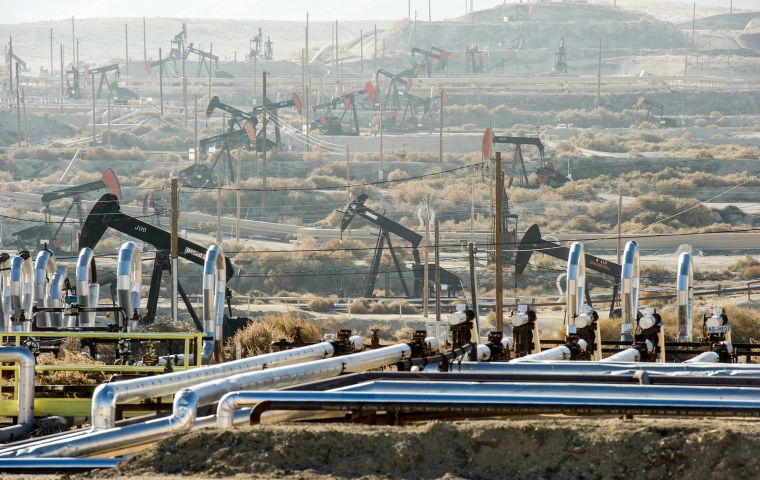MercoPress. South Atlantic News Agency
US shale oil output surge set to influence world market in next five years
 Non-OPEC production is set to rise 5.2 million bpd by 2023 to 63.3 million bpd. Shale oil production will account for over half of the world's output growth
Non-OPEC production is set to rise 5.2 million bpd by 2023 to 63.3 million bpd. Shale oil production will account for over half of the world's output growth United States shale oil output is set to surge over the next five years as drillers recover rapidly from a three-year slump, the International Energy Agency said, sharply upgrading its previous growth forecasts. A landmark deal in 2017 between OPEC and other oil producers including Russia to curb output in order to battle a global glut materially improved the outlook for other producers as oil prices rose sharply throughout the year, the IEA said.
Non-OPEC production is set to rise by 5.2 million barrels per day (bpd) by 2023 to 63.3 million bpd. Shale oil production will account for over half of the world's output growth of 6.4 million bpd, the IEA said in its five-year outlook report Oil 2018.
“Despite talk of capital discipline and increased focus on returns rather than growth, U.S. producers regrouped quickly when oil prices stabilized and began to rise,” the IEA said.
U.S. crude oil production will rise by 2.7 million bpd to 12.1 million bpd by 2023, as growth from shale, known as light tight oil, more than offsets declines in conventional supply. Natural gas liquids will add another 1 million bpd to reach 4.7 million bpd by 2023.
With total liquids production reaching nearly 17 million bpd in 2023, up from 13.2 million in 2017, the United States will be by far the world's top oil liquids producer. Production in 2017 rose by 670,000 bpd as drillers added 200 rigs “beating all expectations”, the IEA said.
Last year, the IEA forecast U.S. shale production to grow by 1.4 million bpd by 2022 with oil prices of up to US$60 a barrel and by up to 3 million barrels with oil at U$80 a barrel.
US shale oil output is set to surge over the next five years, moving the US, once the world's top oil importer, closer to self sufficiency, the International Energy Agency said.
“The United States is set to put its stamp on global oil markets for the next five years,” said Fatih Birol, the IEA's executive director, in a statement.
Oil production growth from the United States, Brazil, Canada and Norway will more than meet global oil demand growth through 2020, the IEA said, adding that more investment would be needed to boost output after that.
Non-OPEC production is set to rise by 5.2 million bpd by 2023 to 63.3 million bpd with the United States alone accounting for nearly 60% of global supply growth.
Growth will be led by the Permian Basin in Texas and New Mexico, where output is expected to double by 2023.
By contrast, output from OPEC producers will grow at a much slower pace, the IEA said, adding it expected Venezuelan production declines to accelerate offsetting gains in Iraq. As a result, OPEC's crude oil capacity will grow by just 750,000 bpd by 2023.




Top Comments
Disclaimer & comment rules-

Read all commentsBehind a sad country, there is always a happy oil refinery: REF:
Mar 07th, 2018 - 11:28 am 0http://slatingnews.com/american-oil-refineries-sponsored-coup-brazil/
Commenting for this story is now closed.
If you have a Facebook account, become a fan and comment on our Facebook Page!